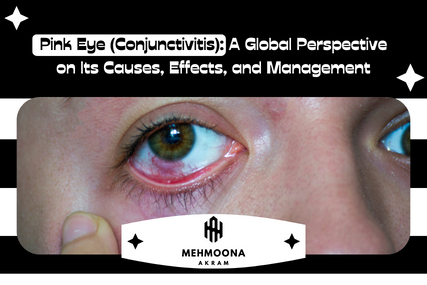
Introduction
Pink eye, medically known as conjunctivitis, is a common eye condition that affects millions of people worldwide. It is characterized by the inflammation of the conjunctiva, the thin, transparent membrane that covers the white part of the eye and lines the inner surface of the eyelids. While pink eye is generally not a severe condition, its impact on individuals and countries can be significant, particularly when it spreads as an infectious outbreak. This article explores what pink eye is, its various causes, and its effects on individuals and countries globally.
Understanding Pink Eye
- Types of Pink Eye:
Pink eye can be categorized into three main types:
- Viral Conjunctivitis: The most common form of pink eye, caused by viruses like adenoviruses or herpes simplex virus. It is highly contagious and often spreads rapidly in crowded settings.
- Bacterial Conjunctivitis: Caused by bacteria such as Staphylococcus aureus or Streptococcus pneumoniae. It can lead to more severe symptoms and complications if left untreated.
- Allergic Conjunctivitis: Triggered by allergens like pollen, dust mites, or pet dander. It is not contagious and typically occurs in individuals with allergies.
Symptoms:
The symptoms of pink eye can vary depending on its cause, but common signs include:
- Redness and irritation of the eye.
- Excessive tearing or discharge (viral or bacterial conjunctivitis).
- Gritty or itchy sensation in the eye (allergic conjunctivitis).
- Swollen eyelids.
- Sensitivity to light.
- Crusting of the eyelids, especially in the morning (bacterial conjunctivitis).
The Global Impact of Pink Eye
Economic Impact:
- Healthcare Costs: Pink eye contributes to substantial healthcare expenditures, including doctor’s visits, medications, and hospitalizations in severe cases.
- Workforce Productivity: Affected individuals often need time off work or school to recover or avoid spreading the infection, resulting in lost productivity and economic disruptions.
Educational Impact:
- School Absenteeism: Pink eye is a leading cause of absenteeism among school-age children. Frequent infections can hinder academic progress.
- Educational Costs: Schools and parents may incur additional costs related to medical care, eye drops, and missed school days.
- Public Health Impact:
- Outbreaks: In densely populated areas or institutions such as schools, childcare centers, and nursing homes, pink eye outbreaks can quickly spread, overwhelming local healthcare systems.
- Disease Surveillance: Monitoring and controlling pink eye outbreaks require substantial resources and coordination within healthcare and public health systems.
Global Trends and Regional Variations
Prevalence:
- Developing Countries: Pink eye is more prevalent in developing countries due to limited access to clean water, sanitation, and healthcare facilities, making it easier for infections to spread.
- Developed Countries: While pink eye is common worldwide, developed countries tend to have better hygiene practices and healthcare infrastructure, reducing the severity of outbreaks.
Seasonal Variation:
- Allergic Conjunctivitis: Seasonal allergies can lead to periodic spikes in allergic conjunctivitis cases during high pollen seasons.
- Viral and Bacterial Conjunctivitis: These forms can occur year-round but may exhibit seasonal variations due to climate and personal hygiene practices.
Management and Prevention
Treatment:
- Viral Conjunctivitis: Usually resolves on its own within a week or two. Supportive care includes lubricating eye drops and cold compresses.
- Bacterial Conjunctivitis: Antibiotics are typically prescribed to shorten the duration and reduce contagiousness.
- Allergic Conjunctivitis: Antihistamines and corticosteroid eye drops can provide relief from symptoms.
Preventive Measures:
- Hand Hygiene: Frequent handwashing can help prevent the spread of viral and bacterial conjunctivitis.
- Avoiding Contact: Individuals with pink eye should avoid close contact with others and refrain from sharing personal items like towels and eye makeup.
- Allergen Avoidance: For allergic conjunctivitis, identifying and avoiding allergens is crucial in preventing recurrence.
- Vaccination: In some cases, vaccines against specific viral causes of conjunctivitis, like adenovirus, can help prevent outbreaks.
Conclusion
Pink eye, or conjunctivitis, is a common eye condition with various causes and consequences. Its impact on individuals and countries can be significant, ranging from healthcare costs to educational disruptions and public health challenges. The prevalence and severity of pink eye vary globally, with developing countries often facing greater challenges due to limited resources. Prevention and management strategies, including good hygiene practices, appropriate medical treatment, and vaccination when available, are key to mitigating the impact of pink eye on communities and countries worldwide. Collaboration between healthcare providers, public health agencies, and individuals is essential to control and prevent outbreaks and reduce the burden of this common eye ailment.



